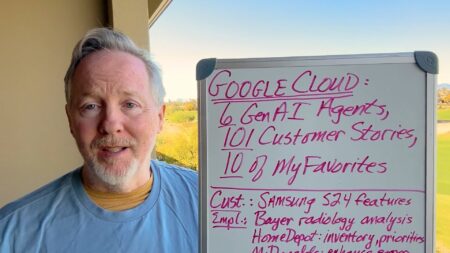In episode 22 of the Growth Swarm podcast, John Siefert, Scott Vaughan, and Tony Uphoff discuss the “myths and realities” of sales and marketing alignment, which has completely changed in a world of subscriptions, annual recurring revenue, and customer-centricity. John says this topic is “akin to the alignment of business and technology” in terms of the challenges and approaches.
00:44 – John asks Scott, who has been “go-to-market expert across the Acceleration Economy Analyst network,” if they are “over-complicating this stuff.”
00:58 – Scott, who has spent a decade in sales and more than a decade in marketing, says the challenge the industries are facing is trying to fix something by trying to align sales and marketing. He says that this approach – trying to turn salespeople into marketing people or telling marketing people to “follow up” – is not natural, and that today, the go-to-market is much bigger than sales and marketing. Scott says there is no doubt that “we are trying to put these two things together, but it’s a bit of chaos.” However, in terms of the bigger picture, Scott says that while go-to-market is still about sales and marketing, contracts between businesses and customers now go on longer due to subscription and recurring revenue models, which changes the game. He says there is a lifetime customer value element that reiterates the importance of the product, which involves product teams and operations teams.
02:41 – John asks Tony for his thoughts on “trying to mash two things together that should naturally be together” or if technology has gotten in the way of this. Are we trying to “over-IT” and “over-tech stack” this environment?
03:25 – Tony says he loves this topic, and shares that it’s the number one topic in which CEOs, private equity firms, and venture capital firms privately engage him. He says that technological change precedes cultural change, and it may take another decade until they are able to understand the disruption that marketing automation and advertising technologies have brought within the marketing function. Tony agrees with Scott that there has not been much progress in aligning sales and marketing in the last decade and notes the “mismatched expectations” and “poorly aligned incentives”: The attribution game has exacerbated some of the cultural differences. He says that the path forward may mean to quit thinking about technology as the answer. Tony says that the biggest challenge he has seen in the last 10 years is that marketing introduces and establishes the relationship between a brand and its customers and sales needs to “understand how to ride on top of that.” He predicts it will take more time to “work through and understand how to use these technologies productively.”
06:19 – John gives an example of a time he took over as a chief marketing officer for a startup company and describes how during the process, he learned that if he started by understanding the customer and their worries – by meeting them where they were — he would be led down a path of marketing to drive conversion of that audience. He asks Scott if he was looking at it too simplistically.
Join us on October 27, 2022 for Acceleration Economy’s Data Modernization Digital Battleground, a digital event in which four leading cloud vendors answer questions on key considerations for updating data strategies and technology. Register for free here.
08:11 – Scott says he doesn’t think John was looking at it too simplistically and states that he, too, struggles with this concept. He says that John has it “crystallized” in meeting the buyer where they are and describes where he thinks the process goes wrong. He says that marketing departments try to serve sales departments as their customers. However, since only 17% of time in the B2B world is spent with salespeople, it means that marketing has to play a larger role in general business operations.
10:16 – Tony brings up the concept of “interest to invoice” and says it is driven by customer experience. In a lot of B2B companies, the customer sometimes gets obscured, but the clarity of focus on the customer is essential.
11:29 – Scott adds that it’s important to define positions for all departments to play in as a way to prevent companies from becoming siloed. He says obsessive internal processes and multiple handoffs are something the customer feels, ultimately affecting business growth.
12:32 – John asks everyone to come up with three solutions that can help companies manage through the process of aligning sales and marketing. John starts by saying that organizations must first understand their customer’s context, as it will help organizations empathize with customers to better serve them. Second, companies must “ditch the jargon” and focus on words that have real meaning to people. Finally, John says that companies shouldn’t pitch, but rather, create demand by leading with intelligence. He says that adopting an attitude of leading with intelligence will work its way through the organization, acting as a “cultural PowerPoint” for the business.
14:32 – Tony says that his number one solution for combining sales and marketing is being customer-centric. He says that if organizations are not focused on the customer and their needs, nothing will get very far. He says that his second solution is data modernization, which will streamline a company’s data into “a single component of truth” and help reduce silos.
17:49 – Scott says that attribution, while it’s important to metrics, is something that may have been “over-engineered.” He acknowledges the importance of metrics, but notes that they can “instill bad habits and actually put conflict between marketing and sales” and then the rest of the organization may not know what to do. Second, Scott says we also need a mind shift change away from “capturing” demand or interest and lead with creating that demand, focusing on the challenges and gaps that customers are dealing with versus “our products.” Scott says that marketing and sales get “off-kilter,” because they are not in sync with the idea of leading. Third, he adds that there must be common metrics that are shared at regular business review meetings to ensure everyone is seeing the same data at the same time.
20:22 – Tony agrees with Scott and advises companies to “get out of vanity metrics.” He says companies are “tracking edgy, peripheral data that is not moving the needle in terms of dazzling customers and driving revenue.”
21:14 – Even so, Scott says it’s still important to track vanity metrics as they can help sales and marketing improve, but they just don’t need to be presented. He says the problem with vanity metrics is that “we put those as our flag that we are riding with.”
22:05 – John wraps up this week’s episode by reiterating the importance of leading with intelligence to create demand, rather than delivering a pitch or doing thoughtless e-mail blasts. He says that next week, the team will be back with its regularly scheduled Growth Swarm episode as Bob returns from Google Cloud Next and Oracle CloudWorld, and looks forward to Acceleration Economy’s upcoming coverage of Celosphere.
Want more tech insights for the top execs? Visit the Leadership channel:








